Manitoba Peer Supporters
Manitoba Peer Supporters are technology champions available to help others navigate through the expanding network of digital health solutions.
They provide coaching and advice through both one-on-one consults and group education sessions. Our Peer Supporters can answer questions, share their experiences, provide guidance on the best use of available health-care technologies or direct others to specialized resources.
Our dedicated group of Peer Supporters include family physicians, specialists, nurses and nurse practitioners, physician assistants, clinic managers and key EMR resources.
Choose a Peer Supporter below for more information about their experience using electronic medical records (EMRs).
Family Physicians
Dr. Amanda Condon

Family Physician
ACCESS River East, Winnipeg RHA
EMR user since 2011
Biggest Challenge when first started using an EMR
Generating the medication list was difficult at first. Also, maintaining an accurate list of all medications that a patient is taking including medications prescribed by others is an ongoing challenge.
She also recommends using vendor trainers, especially those who have a clinical perspective.
Best parts of using an EMR
- Organization: she likes having everything in one place.
- Lab results: she’s able to pull up lab results easily.
- Medications: she likes the ability to see a quick snapshot of the patient’s history.
Advice to those starting out
“I think there is a huge benefit to having positive physician leadership. Physicians who are motivated and really keen about using an EMR will make the experience more positive.”
Daily use
When she first started out, she didn’t realize importance of data standards – of sticking to standard codes instead of using custom codes and of placing particular information in particular places within the EMR. One they realized the importance, they changed the approach after the EMR was in-place.
Tip
If possible, keep your paper charts and pull them for several months as you use the EMR. Then, scan selectively over time rather than scanning everything upfront.
“Your view will change regarding what’s necessary (to scan) over time.”
Dr. Mark Duerksen

Family Physician
Steinbach Family Medical Corporation, Steinbach
EMR user since 1999
“The EMR is instrumental in helping define your practice population.”
Biggest Challenge when first started using an EMR
“Any time you change a workflow that previously was automatic, you have to put conscious mental energy into making it different. Eventually that behaviour becomes automatic and you do it without thinking.”
Best parts of using an EMR
- Medication management: he is able to more quickly see what a patient’s medication history, including when their medication has been changed, if there has been reactions, and why medications were stopped.
- Legibility: he can more easily read both his own charts and those of his colleagues.
- Lab and report management: it’s easier to know when labs and reports come in and whether they’ve been reviewed. He finds the filing easier as it isn’t limited to chronological order.
Advice to those starting out
“Visit clinics that use EMRs and don’t skimp on training.”
Daily use
The EMR has helped overall communication. His clinic uses an automated reminder feature to note when patients need to be called back for followups. He also uses instant messaging for immediate communication with staff.
Tip
“You have to buy into the continuing education processes, just like in medicine. The EMR and the workflows associated with EMRs are also a continuing education process. There’s always something to improve. If you can buy into that, that there is reward in learning say, one new thing a month, it will go a long way to making your life easier.”
Dr. Theo Fourie

Family Physician
Western Medical Clinic, Brandon
EMR user since 2003
“I could never see myself moving back to paper. I wouldn’t be able to find anything or read anything.”
Biggest Challenge when first started using an EMR
Overall, the change from paper to EMR was not too difficult. He embraced the change because he likes computers and innovative technologies.
Best parts of using an EMR
- Forms: he digitizes all of his manual forms. This way, when he opens the form in the patient’s record, some information is automatically populated.
- Prescription writer: his EMR’s prescriptions writer does cross-checks for possible interactions with other drugs.
- Overall organization: the record was organized to make access to key information as easy as possible.
Advice to those starting out
“If you contemplate organizing the EMR with document headings, make sure you sit down with all the players to sort it out.” His clinic involved every role, made a master plan and then adjusted it as need be. “We made it the most logical for everyone.”
Daily use
When interacting with patients, it’s easy to quickly show growth chart, trend lab results and share other information. “Patients appreciate that. They also ask for copy of these trends. I always see it as educational, make them involved in the decision making.”
Tip
“Every six weeks or so, we have a lunch where we show others how to do things in the EMR.” He shows other physicians his workflow and breaks it down so it’s easy to understand and incorporate.
Dr. Ian Kasloff

Family Physician
Lac du Bonnet Medical Group
Dr. Harold Nyhof

Family Physician
Access Winnipeg West, Winnipeg RHA
EMR user since 2007
“The ability to access eChart Manitoba directly from the EMR allows patients to be more engaged in their health care and makes health data readily available for providers.”
Biggest Challenge when first started using an EMR
Entering relevant patient history and medical conditions was very time consuming.
Best parts of using an EMR
- Ability to remotely access the EMR securely from any location.
- Ability to receive labs electronically.
- Increased efficiency from features and functions such as faxing prescriptions directly from the EMR and integrated links to clinical decision support tools, and the ability to develop and use macros to improve consistency and reduce time with documentation.
Advice to those starting out
Just stick to basic functionality and increase learnings as you get comfortable with the basics.
Daily use
Patients are highly engaged when he accesses eChart Manitoba for lab results. Many patients are amazed that their data is so readily available.
Tip
Talk to your peers for tips and tricks. After people use the EMR regularly they learn new and interesting workflows.
Dr. Sheldon Permack
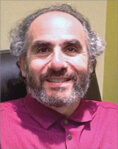
Family Physician
Dr. Sheldon Permack Medical Corporation, Winnipeg
EMR user since 2010
“The EMR allows me to file, organize and view patient information in a much more systematic and intuitive way.”
Biggest Challenge when first started using an EMR
Changing the workflows (i.e. the order of how tasks are completed) was the most difficult. Before the EMR, completing a consult required him going into the chart, writing down the information, passing it to his assistant who photocopied the paper, etc. With the EMR, the workflow is completely changed. He and his assistant worked collaboratively to figure out the most efficient way to complete work.
Best parts of using an EMR
- Patient callbacks: he uses the EMR to automate patient followups for their conditions.
- Automated consult letters: he uses his EMR to auto-populate all patient information and easily attaches additional information to the letters.
- Macros and templates: his surgical reports, post-operative instructions and other documents are templates in macros, reducing time required to fill them out.
Advice to those starting out
“Visiting sites that use EMRs and comparing all products is crucial before selecting one for your practice or clinic.”
Daily use
Remote access has made a big difference for him. When out of town or away from the clinic on the weekend, he is able to check patient information and react accordingly. This has made a big difference on a few occasions, where the patient required immediate care.
Tip
“If you have a varied family practice with a primary-care home philosophy, you will be seeing patients over the course of many years. It is therefore very helpful to organize information by disease category.”
Dr. Alex Singer

Family Physician
Family Medical Centre, University of Manitoba, Winnipeg
EMR user since 2010
“There is a huge up-front investment to get data into the EMR. It’s a challenge and it takes time. You don’t turn on the system and it works.”
Biggest Challenge when first started using an EMR
During the transition, it was challenging to remember what information was still in the paper chart and what was in the EMR. It took a while to learn when you needed to go back to the paper chart for something.
People within the clinic had high expectations about using the EMR. They experienced some frustration about what they were able to do within the EMR while they were still learning. Make sure that you have open and regular communications; talk to each other, share tips, etc. to help manage the learning curve.
Best parts of using an EMR
- Consistency: in the paper, he used several methods to work, including sticky notes, pieces of paper. With the EMR, he uses one.
- Speed: he can look at the chart and see the relevant, important information at a glance.
- Legibility: reading charts is much easier.
Advice to those starting out
“Think very clearly about how work flows within their clinic. Try and ensure the EMR enhances people’s duties and makes their activities more efficient rather than slowing them down. You need to understand well how the clinic functions and everyone’s roles. It is important not to take away rights and roles and responsibilities.”
Daily use
They are slowly expanding their use of EMR reports for day-to-day clinic activities. They already use reports for outstanding imaging requisitions to make sure they are sent and that patients have appointments. They also use the EMR reports for quality check to make sure all referrals were sent, for example.
Tip
EMR reporting is key to practice reflection.
Specialists
Dr. Barry Bermack
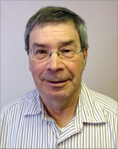
Family Physician
Dr. Barry Bermack Pediatric Clinic, Winnipeg
EMR user since 2011
“I can see all the diagnoses, all the drugs the person was on recently, all the immunizations, in one look. For speed and efficiency, it’s great.”
Biggest Challenge when first started using an EMR
He decided to use templates and macros, and building them took some time up-front. He says the time investment has paid off as those processes have become much quicker for him.
Best parts of using an EMR
- Organization: he has all the information in one place.
- Efficient summaries: his EMR gives him the ability to send a summary to a hospital.
- Legibility: his prescriptions are readable for pharmacists and take only a few clicks to renew.
Advice to those starting out
“Be patient with yourself. Moving to an EMR is a change, and it can be difficult at first. But six months later, you’ll be wondering why you didn’t do it earlier.”
Daily use
He uses electronic tasks as a way to assign work to others in the clinic. As a result, clinic communication has improved. He also uses dictation and voice recognition software, which enters his notes directly into specific areas of the chart.
Tip
He took time to explain the EMR to patients when he began using it. He would answer questions and demonstrate things, such as locking the computer when he leaves the room. The result: patients were comfortable with and supportive of the new technology.
Dr. Trevor W.R. Lee

Family Physician
Digital Health, Shared Health
The Chief Medical Information Officer for Digital Health has a mandate to promote the information system and technology requirements of clinicians in the front lines. The adoption of EMRs by family physicians and first responders is a key element in the clinical transformation that has to occur in health care.
Pre-emptive care, prophylaxis and chronic disease management facilitated by an appropriate EMR will radically improve population health on a case by case basis. Communication, connectivity and access to the right information at the right time will make life easier for the clinician. And now is the right time to acquire an EMR as these applications have matured significantly in the last few years.
We can look forward to legible notes and prescriptions, sophisticated patient tracking and alerts, and excellent secure web based connectivity.
Welcome to the future!
Other Health Professionals
Josh Kahanovitch

Physician Assistant
Our Own Health Centre, Winnipeg
EMR user since 2014
“In certain circumstances, being able to show a change over time can help support your recommendations to the patient.”
Biggest Challenge when first started using an EMR
When Josh first started using an EMR he had difficulty finding the different features and then picking out what information he needed from the results presented to him. Soon after, he learned some quick buttons and keys to quickly put together the information he was looking for.
Best parts of using an EMR
- Convenience: Josh likes being able to access almost everything he needs from one screen. He can take notes, write a prescription, and update a medical history all from the EMR.
- Up-to-date: “I like that reconciliation of requisitions and referrals is done as information comes in. It helps to keep track of referrals that haven’t been followed up, or tests that haven’t been done or reported yet.”
- Traffic Manager: The functionality of the Traffic Manager helps staff know where a particular patient is at any time. Josh has found this especially helpful when a patient has appointments with multiple practitioners.
Advice to those starting out
“Never be afraid to ask for help. Get comfortable with one area instead of trying to tackle too many things at once.”
Daily use
“I use the EMR to relay information. For example, showing results to patients allows for a discussion and allows me to trend the results. In certain circumstances, being able to show a change over time can help support your recommendations to the patient.”
Tip
Josh recommends EMR users spend time using the EMR on test patients. He believes this is the best way to explore the various functions without fear of altering a person’s chart. It gives a sense of comfort that comes from experience.
Scott Naherniak

Physician Assistant
Dr. Sheldon Permack Medical Corporation, Winnipeg
EMR user since 2013
“I would not, and could not, work in an office without an EMR.”
Biggest Challenge when first started using an EMR
“I didn’t find any specific feature difficult to integrate. It took a couple of weeks to learn how to navigate through the EMR and learn an efficient flow. That being said, being a physician assistant, I review the entire chart and patient history each visit. It would be unrealistic to do this quickly without EMR.”
Best parts of using an EMR
- Tasks: He finds tasks helpful to send reminders for follow-ups and repeat studies.
- Search feature: He likes that he can quickly search a large number of documents saving him a lot of time.
- Macros/Forms: He uses them to quickly and accurately create and send consult letters, chronic disease management forms, X-ray requisitions, lab requisitions, and other investigation forms.
- Lab profiles: Scott likes that he can quickly see when last labs where completed and have them organized in an easily interpretable manner.
Advice to those starting out
“The EMR can be optimized for your office patient population and is an excellent tool for teaching. Your EMR is only as good and accurate as your entries.”
He emphasizes that having an office system/culture to continually review and update the charts to ensure they are accurate (medication list, past history, lifestyle, problem list) is what makes its integration and use successful. With ongoing learning, EMRs are extremely powerful.
“I would not, and could not, work in an office without an EMR.”
Daily use
Scott’s office practices in a “Max Pac” model. Each visit they review their patient’s chief complaint as well as their whole chart. He says patients enjoy that they are taken care of in a manner where they do not have to keep returning to the clinic.
Since he works as a physician extender, he says that patients like that both he and the doctor are working off the same information and share chart notes. “They always comment on how happy they are with the way their information is kept.”
Tip
“GIGO (Garbage in, garbage out)! I have been to offices where the culture of keeping the chart clean with current and up-to-date data has been lax. This really limits the power of EMR and the ability to serve the patient. It only takes a few moments to keep the chart clean saving hours of work later.”
Lyndsay Palsson

Family Nurse Practitioner
Riverton Community Health Office, Riverton
EMR user since 2013
“Expect initial frustration and information overload – but take comfort knowing that all this new information and learning will be worth it in the end.”
Biggest Challenge when first started using an EMR
Lyndsay shares openly and honestly that everything was challenging at first. But in her experience, the more you learn and use the EMR, the easier it becomes. She notes it is often time consuming initially but in the end it definitely increases efficiency.
Best parts of using an EMR
- Scheduler templates: used to configure the schedule to suit her office needs, such as pre-scheduling specific types of appointments (e.g. administrative time, vacation time).
- Customizable configure action buttons: these are a huge time saver for her as they display the requisitions or forms she frequently uses.
- Prescription favorites: provides her with the ability to create and save common prescriptions she writes most frequently, which saves time and makes her more efficient.
Advice to those starting out
“Ask more questions and ask for more support. I wish there would have been support available from an experienced EMR clinician.”
Daily use
Lyndsay often reviews results, consults and lab trends with patients on screen. When patients can see for themselves and follow along in the conversation, she notes they seem to have more interest in their health care. In her role, Lyndsay is also using the EMR more frequently to help track prevention efforts with primary care quality indicators for patient care. She has recognized that patients tend to be quite curious about the EMR and are amazed with what can be accomplished using the system. To date she has not had one negative comment from a patient — they are relieved to know their information is visible to other EMR users should they require care elsewhere in the Interlake Eastern Regional Health Authority.
Tip
“Be open to learning new things, and give an adequate trial before dismissing something that could potentially benefit your work; the more you use EMR the more you will see what it can do for you in optimizing patient care. Use it to your full advantage; it will make your job easier.”
Brenda Schoenborn

Nurse Practitioner
Steinbach QuickCare Clinic, Steinbach
EMR user since 2012
“Don’t give up using it. It will pay off.”
Biggest Challenge when first started using an EMR
“Trying to ensure the information is put into the chart correctly and in the correct place. Once this is done it is easy to find what you need. Medical history, current meds and allergies are all easily visible on the chart at any time.”
Best parts of using an EMR
- Making referrals: Brenda finds it helpful that the EMR is able to self-populate patient demographics, medical history and current medications right on to the referral letter. She adds that most physicians are in their address book within the EMR, making faxing to the office much easier.
- Writing prescriptions: She is able to save any prescription she writes as a favorite, making it easier to find the exact prescription she would like to order.
- Easy-to-read charting: No guessing as to what a word is.
Advice to those starting out
“Don’t give up using it. It will pay off. Don’t be scared to click around the chart and see what else is available for you to use and make your day easier.”
Daily use
“I have used the past medical history for medication reconciliation. The patients are happy that I am able to see what was ordered in the past so they don’t need to remember.”
Tip
“Once you are somewhat comfortable with the daily uses of the EMR, investigate further and find other things it can do. And use templates for all letters, referrals, and requisitions. It is helpful to not have to flip through papers to find the appropriate referral form to send.”
Key Clinic Staff
Ruheen Aziz

Clinic Owner / Manager
Winnipeg
EMR user since 2010
“Macros and Templates are your best friend!”
Biggest Challenge when first started using an EMR
Ruheen says that billing in the EMR required a lot of training. She also notes that more discussion on how the clinic was going to file in the EMR would have been beneficial.
Best parts of using an EMR
- Traffic Manager: Ruheen likes the Traffic Manager feature because it gives her a clear view of where all the patients are located in the clinic.
- Query Builder: The Query Builder allows Ruheen to run reports on almost any data fields in the EMR. This tool provides accurate reporting and helps her find the statistics she needs quickly.
- Remote Web Access: This feature allows Ruheen to log into the EMR from anywhere, anytime.
Advice to those starting out
“I think it’s key to have proper processes and procedures in place before go-live. If you just jump into the EMR without communicating as a team, data in the EMR will not be standardized.”
Daily use
“I think it’s key to have proper processes and procedures in place before go-live. If you just jump into the EMR without communicating as a team, data in the EMR will not be standardized.”
Tip
“Macros and Templates are your best friend!”
Christine Banewski
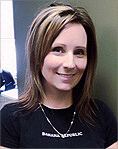
Clinic Manager
Family Matters Medical Centre, Winnipeg
EMR user since 2007
“Get away from post it notes and pieces of paper. Message, task, refer, track everything through the patient’s chart from start to finish.”
Biggest Challenge when first started using an EMR
Christine said standardizing and implementing processes in order for consistency was her biggest challenge when she first started using an EMR.
Best parts of using an EMR
- Accessibility: you can search for patients and access their chart within seconds by using one function key. Not only do you have their chart notes, but also their appointment history, billing information, pending appointments and labs, and outstanding orders.
- Efficiency: you spend less time booking, finding, and rescheduling appointments. Faxes are received electronically. Therefore, scanning is reduced and finding things is easier and faster.
- Communication: clinicians can access messages about a patient in a central location if that is what they choose. If a patient is returning a call, all messages and pending appointments “live” in a common area. With the click of one function key, all of the information pops up.
Advice to those starting out
Communication and consistency is key. Christine recommends EMR users have team meetings with staff and doctors to discuss how to best use the system. Spend more time learning about what the system can do for you rather than just what you need it to do.
Daily use
Christine uses the F7 (task) key every day because it is the communication hub.
“Anyone can access tasks by hitting F7. Want a referral? – Task it. Want a patient recall or to relay a message? – Task it. Need something from health records? – Task it. It is the equivalent of a paper trail.Completed tasks are also archived so it keeps the area clean and relevant.”
Tip
Consistency, communication, and documentation are key. Implementing processes leads to a more efficient, streamlined office. Find out more about the software. The possibilities are endless, so don’t just settle for what you need to use. Learn how to get what you want and need. Call your vendor if you want the software to do something. Chances are it does!
Angela Houston
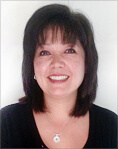
Clinic Manager
Dr. Barry Bermack Medical Clinic, Winnipeg
EMR user since 2011
“Implement the EMR based on your own comfort level… don’t go too fast.”
Biggest Challenge when first started using an EMR
The biggest difficulty experienced was the EMR confusing siblings. Manitoba has two provincial medical numbers – the family number and the individual number. It took time to learn how to ensure the EMR didn’t consider a newborn sibling (without an individual number) with an existing sibling.
Best parts of using an EMR
- Looking up appointments: many people call the clinic, not remembering when their appointment is. With her EMR, searching by name eliminates the need to search day by day.
- Legibility: “You can read the ‘writing’ because it’s not writing.”
- Ease of printing the immunization record: her EMR prints the record out with a few clicks. Before there would be several steps to get to that point.
Advice to those starting out
“Try not to feel overwhelmed by the whole thing. Introduce the EMR as a process, learning features one at a time.”
Daily use
Looking up everything is faster for her than it was flipping through paper charts. The clinic used to have one chart per family, and it was easy for information to be misfiled into the wrong sibling’s grouping. With the EMR, this doesn’t happen.
Tip
She says running reports to determine how many patients have a specific diagnosis or who take specific medication is very easy and can be very useful.
Sandra (Sandi) Levandoski
Business Manager
Brandon, Manitoba
EMR user since 2007
“You don’t need to learn everything in one day! Learn one thing at a time and find your most effective workflow through networking with others and learning and exploring on your own.”
Biggest challenge when first started using an EMR
Sandi found scheduling the most difficult. Finding the most efficient ways to navigate the schedule by physician and with multiple physicians was challenging to start.
Best parts of using an EMR
- Query building/reporting – Sandi is analytical and finds data and statistics accessed from the EMR interesting and useful
- Tasks/Messaging – These features provide Sandi with excellent communication tools
- Billing/Claims – She enjoys the challenge of managing the accounting side of the clinic
Advice to those starting out
“Rome was not built in a day – learn one thing at a time and find your most effective workflow through networking with others and learning and exploring on your own.”
Daily use
Sandi notes using the EMR helps her improve workflows and work through solutions to inefficiencies. It also provides her with statistical proof and support of required changes.
Tip
“Macros and templates are your best friend!”
Jo-Anne Lutz
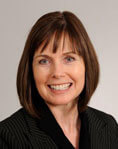
Team Manager
Access Downtown, Winnipeg RHA
EMR user since 2011
“If you are setting up an EMR, ensure you have a good understanding of what to do to prepare it properly for use. Be patient with yourself and others; share tips and tricks with your team.”
Sandy Singleton

Office Manager
Dr. Sheldon Permack Medical Corporation, Winnipeg
EMR user since 2010
“Generating tasks either one at a time or recurring has proven to be our best tool, especially in managing chronic diseases.”
Biggest Challenge when first started using an EMR
“When we first started using the EMR, I found setting up my folders and where I wanted documents to live my most challenging tasks. We were the third practice in the province to implement an EMR, so there wasn’t a lot of help out there from other users. Over time we had to change a lot of things to make it work into what it is today.”
Best parts of using an EMR
- International Normalized Ratio (INR) Tracker: Sandy said the INR Tracker in her EMR makes it easy to see when patients are due for lab work, medication doses, and if they have been notified of results. Sandy finds the electronic INR Tracker a safer way to manage complex patients.
- Tasks: “Generating tasks either one at a time or recurring has proven to be our best tool, especially in managing chronic diseases. It was more difficult to provide comprehensive chronic disease care in paper charts.
- Documents folder: Sandy said sending results to the doctor for review is as simple as loading a patient and clicking a button. When the clinic was paper-based, it was more challenging to manage patient charts.
Advice to those starting out
“Check out a variety of clinics to see how different practices use their EMR. Ask lots of questions and take notes on those visits so you can plan what will work for your own workflows.”
Daily use
Sandy uses the EMR on a daily basis to look for information she needs in patients’ charts. She can access that data at a click of a button instead of sorting through piles of paper.
Tip
“You get exactly what you put into the EMR. In the beginning we worked very hard to set up everything and scan the proper documents in the EMR on every patient. Now we are reaping the rewards of a well-oiled EMR.”
Tim Wolfe

IT Manager
C.W. Wiebe Medical Centre, Winkler
EMR user since 2001
“We have learned the incredible importance (and value) of standardized data entry. Entering the same data, the same way, every time, reduces all manner of headaches.”
Biggest challenge when first stared using an EMR
“Identifying EMR (configuration/templates/process) changes or additions each practitioner needs to best support their practice. It was (and sometimes still is) challenging to manage conflicting needs or expectations, even with relatively standardized tasks.”
Best parts of using an EMR
- Data analytics: being able to customize and build dashboards for almost any query, reporting, or Quality Improvement project has been very beneficial
- Web-based application: being able to access our EMR from any modern browser has made remote access and remote work easier for our medical staff
- Patient communication: being able to send messages and reminders to patients from the EMR (including asking patients to fill out electronic questionnaires) provides new opportunities for improving patient care.
Advice to those starting out
“Be curious! Taking time to explore the EMR, to question ‘What does this do?’ or ‘How can I accomplish that?’ can take you a long way.”
Daily use
He uses the EMR in an administrative and support role primarily adding or editing document and communication templates as well as building analytics dashboards. He also checks the schedules to determine the best time for system maintenance.
Tip
“Collaborate! Where one person may struggle to solve an issue, whether it be care-related or purely technical, two or more people can often find a solution. Even just discussing with your colleagues how you perform a specific task that you struggle with, or that you feel takes too much time, can result in new perspectives or finding new ways to perform that task.”
Peer Supporter Alumni
Michelle Allard
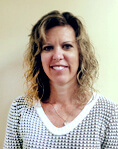
Primary Care Nurse
Family Medical Centre, Winnipeg
EMR user since 2011
“You would be amazed at how your opinions matter and contribute to a more efficient and effective EMR for all users.”
Biggest Challenge when first started using an EMR
In the beginning, Allard found it frustrating to discover blank electronic charts for patients she knew had a long history at the clinic. She did her best to enter pertinent information into the new data base but still had to rely on the paper chart for many things.
Best parts of using an EMR
- Medical Bands in Accuro. Michelle Allard finds this feature very helpful when doing telephone triage because when she glances down the right hand side of the screen she can see a quick health summary of her patient.
- The INR Tracking tool. This tool makes managing, tracking and documenting INR results simple and efficient.
- Appointment History. In a clinical setting with multiple providers, having the Appointment History visible as a side bar allows for easy tracking of appointment visits/providers to facilitate continuity of care.
Advice to those starting out
“Don’t just do things the ‘old paper chart way.’ The EMR provides an opportunity to improve your workflow, so embrace all the options that the system offers.”
Daily use
During new patient intake visits Allard turns her computer monitor towards the patient and walks them through the system. She lets them watch their important information being entered onto the Medical Bands and Patient Profile section. This allows the patient to learn how the information is stored and how it will be retrieved by other providers. New patients respond positively to this process and appreciate the opportunity to see what their new electronic chart will look like and how it will work.
Tip
Don’t be afraid to ask for an improvement to something you think is not working the way it should. You would be amazed at how your opinions matter and contribute to a more efficient and effective EMR for all users.
Dr. Johann Blignaut
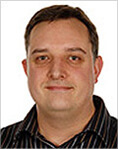
Family Physician
Dr. C.W. Wiebe Medical Centre, Winkler
EMR user since 1999
“You can find information so quickly. The EMR can do things that paper has no ability to do.”
Biggest Challenge when first started using an EMR
His biggest challenge was the upfront time investment to populate the EMR with patient medical history. As he saw patients, he would record information from the visit, but he found it was often too time consuming to populate the chart with the history at the same time. Instead, he would often wait until the end of the day to populate the EMR with history for the patients he saw that day.
Best parts of using an EMR
- Legibility: he can read all his colleagues’ notes.
- Research capability: he uses the EMR to mine data, look at trends, look at individual and group statistics. For example, he can run a report to see how many Diabetic patients he has. He uses these reports to reflect on his practice.
- Remote access: he can access the EMR from home or in the hospital.
Advice to those starting out
“Take it one step at a time: if you are willing to put a little bit of up front time and effort, and the reward at the end is worth it.”
Daily use
He uses the EMR to engage his patients in their own care. For example, he shows his patients graphs on the screen and involving them in referral letters. While he didn’t type when he started using an EMR, he says he’s now charting more quickly with a keyboard than he was on paper.
Tip
Monthly staff meetings can be used in part to share EMR tips.
Anne-Marie Chanel
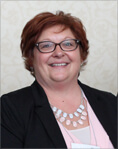
Program Analyst / Home Clinic Liaison
Manitoba eHealth, Winnipeg
EMR user since 2003
“The first three to six months can be pretty tough. After that it gets a little easier, and the benefits are worth it in the end.”
Biggest Challenge when first started using an EMR
It was challenging for some to let go of their paper processes and transition to the EMR. Anne-Marie tried to encourage people to move forward, taking into account their comfort with technology. The change is more significant for those who haven’t used a computer before.
Best parts of using an EMR
- Availability of information: the EMR enables reporting that just wasn’t possible in the paper world.
- Patient tracking in clinic: the EMR has a feature that enables tracking of the patient from the time they arrive to the time their appointment is over.
- Electronic forms reduce tracking: the EMR automatically records that requisitions or referrals are created and notes them as outstanding until they are reconciled. Outstanding items can be reported easily so there is less tracking to do.
Advice to those starting out
Anne-Marie suggests clinics really think through manual processes or workflows and work with their EMR vendor to see how the processes could be improved in the EMR world.
Daily use
Anne-Marie works with many clinics, helping them to implement the EMR and to use it more effectively over time. One of her regular activities is using the EMR to report a variety of information to the clinics. Anne-Marie provides information about patient access, continuity of care and reports to help them reflect on their patient population.
Tip
She says you can run reports to explore continuity of care if you have a clear panel of patients. Reports can show providers how many times their patient saw them and any other provider in the region. It’s good information for the provider.
Marc Desjardins
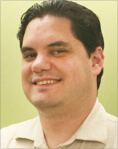
Executive Director / ICT
Assiniboine Clinic, Winnipeg
EMR user since 2011
“Don’t be afraid to break the chart. If you don’t know what a button does, click it and find out.”
Biggest Challenge when first started using an EMR
His biggest challenge was reporting. While very useful, it took some time to learn how to effectively search and get the information he wanted onto the report.
Best parts of using an EMR
- Access to information: Whether it be reporting, looking up something on one person’s chart or having the record up to date so any other providers who need to provide care to the patient have all the relevant information.
- Aggregate data: Using our EMR we can now properly measure physician’s productivity and patient panels.
- Secure Documents: Nothing ever goes missing. There is always some way to track down who touched what and who filed what where.
Advice to those starting out
Marc recommends you be adventurous. Don’t be afraid to break the chart. If you don’t know what a button does, click it and find out. There is very little your vendor or IT people can’t fix.
Daily use
As a Clinic Manager, Marc frequently uses the EMR to see what physicians are in the office on a given day, how many patients each physician plans to see, and at what time they are seeing those patients. This is useful in budgeting Marc’s time to ensure that when he goes to speak with a physician, he knows they have the time they’ll need.
Tip
Don’t be afraid to click on something. You will find all sorts of features and shortcuts that you had no idea were there.
Dr. Kiet Do

Family Physician
Family Matters Medical Clinic, Winnipeg
EMR user since 2012
“My patients have found it very helpful and there has been less need to print out paper copies.”
Biggest Challenge when first started using an EMR
“My biggest challenge was trying to add billing tariffs after each visit. This was difficult because I never had proper training about tariffs or billing using the EMR.”
Best parts of using an EMR
- Less paper: Dr. Do finds there is less need to print out paper results for patients when they can see their results in the EMR.
- Lab result trending: she finds trending lab work is great for patient counseling.
- Efficiency: it saves her time when caring for her patients.
Advice to those starting out
Dr. Do strongly encourages new users to ask for proper EMR training before starting out.
Daily use
“I use the EMR to review labs/results with patients. Being able to trend results and show patients how they are managing is very valuable. For example, A1Cs for diabetics or Framingham Risk Scores for cardiovascular disease risk. My patients have found it very helpful and there has been less need to print out paper copies.”
Tip
Dr. Do promotes using features in your EMR to send tasks or set alerts to remind you of things you need to follow-up on.
Elsie Duff

Nurse Practitioner
Selkirk Quickcare Clinic, Selkirk
EMR user since 2013
“Take time to use the templates, macros, and favourite prescriptions.”
Biggest Challenge when first started using an EMR
When she first started using the EMR, Elsie did not understand that templates and macros were two different things and many of the same templates were created as macros or vice versa in the regional EMR.
Best parts of using an EMR
- At a glance view: Elsie finds the use of a specific quick viewing feature in the encounter notes section of her EMR allows her to quickly read a series of clinical notes across care-providers for her patients.
- Favorite prescriptions: she likes that this feature allows her access to regularly used medications versus searching for the medication with each prescription.
- Templates and macros: she is able to use these features to efficiently generate clinical notes.
Advice to those starting out
“Take time to use the templates, macros, and favourite prescriptions. Also, access your EMR’s User Guide for support – I found the tips and tricks in the guide helpful.”
Daily use
“Frequently, we view lab test results on the screen and discuss them during a visit.” She finds this helps to better educate her patients and makes them feel more involved in managing their own healthcare.
Tip
“The professional Nurse Practitioner (NP) credential to identify a care provider is not a feature available in the EMR. A way around this is to sign an electronic signature with your name followed by your professional credential, for example “John/Jane Doe, NP”. Using the NP title with the care provider electronic signature helps address the College of Registered Nurses standard to accurately represent and clearly communicate a name and professional designation at the end of a signature.”
Dr. Denis Fortier

Family Physician
Notre-Dame-de-Lourdes
EMR user since 1990
“The ability to trend lab work in graphs or tables – my patients don’t even know how we did without it.”
Biggest Challenge when first started using an EMR
Migrating the data from the paper chart to the EMR was the most difficult part. Dr. Fortier would go through patient charts at the end of the day and make sure the key pieces were in the EMR.
Other members of the clinic team would do the same. Together, they chipped away at inputting data when they had the time. “Every single one of us worked together to input the necessary data.”
Best parts of using an EMR
- Ability to trend lab work in a table or graph is unbelievable.
- Legibility means sharing patients among doctors has become so much easier.
- Access to information – it’s easier to retrieve consults and DI reports.
Advice to those starting out
Take the time to really talk about workflows in the clinic. Map out the workflows and think about how things are done today and how they could be different. Then go out and see if and how a vendor could help.
Spend a lot of time comparing different EMRs.
Daily use
The EMR tracks where patients are in the clinic, making patient flow much smoother.
Tip
The education never ends to better use an EMR.
Philip Fourie

Clinical Assistant
7th St Health Access Centre, Brandon
EMR user since 2014
“Just play around as much as you can, learn from others! I am constantly learning new things by just asking other users how they use the system.”
Biggest Challenge when first started using an EMR
Phil found selecting which diagnosis codes to use when setting up a patient’s chart an initial challenge which would take a lot of time to figure out. Now he selects from a configured list of the most common diseases he sees to streamline the data capture of this information.
Best parts of using an EMR
- Annotation functionality: Phil notes this ensures the office stays as paperless as possible.
- Electronic faxing: eliminating the manual fax supports his goal of promoting a more paperless office; in addition, the clinic can see when faxes have not been delivered and a record of faxes sent/received for better tracking.
- Tasking for reminders in future: Phil leverages this EMR functionality as a great way to stay on top of things like screening for his patients.
Advice to those starting out
“Set up lists of favourite prescriptions and diagnoses. This saves a lot of time for daily workflow.”
Daily use
Phil has developed panels to track lab data in the EMR. He shows these lab panels to his patients, which gets them involved in their own care. He notes they often ask for printed copies of the panels, which helps to keep patients educated and informed about their health status.
Tip
“Always keep your patient charts up to date, for example by adding new diagnoses or if social history changes. This saves a great deal of time.”
Dr. José François

Family Physician
Centre de santé St. Boniface, Winnipeg
EMR user since 1999
“We have had our challenges, but none of our physicians would go back to paper charts.”
My EMR experience
Centre de santé St Boniface is a community health centre located on the campus of St Boniface General Hospital. The Centre serves residents of the St. Boniface neighborhood as well as the French-speaking population of Winnipeg. Since its inception, the number of health professionals working in the centre has grown and now includes: five family physicians, two nurse practitioners, two primary care nurses, a dietician, a social worker, a mental health nurse, a part-time psychiatrist, and a community outreach worker. Since 2005, we’ve also been a teaching site in the University of Manitoba’s Family Medicine residency site and welcome three family medicine residents and multiple medical students every year.
EMR from day one
Centre de santé started with an EMR on day one when it opened in the summer of 1999. Due to limited space, there was little room to store medical records and as all the staff was new, there was an opportunity to train everyone prior to them starting their practice. Unlike other practices, we didn’t go through the transition from paper to electronic records.
Choosing the right system
The choice of EMR was made by our clinic’s administrator, as clinic staff (physician or other) had not yet been hired. In 1999, there were a limited number of software vendors and relatively few other clinics had instituted an EMR. After investigating a number of vendors, a local vendor was selected as it provided Manitoba Health-compatible billing software and supported an EMR from a national company which it represented. Although medical staff were not involved in the initial selection process for the EMR, many of the functionalities we were looking for were present: electronic prescribing, medication interaction/allergy alerts, well laid-out dashboard, ability to trend results and customize templates.
Upgrades to hardware and software
Over the years, software upgrades have improved functionality of the EMR but this has not always been without problems: temporary interruptions in service, system “glitches” and inadequate hardware to support software. We’ve also had to plan for replacement and upgrade of hardware (servers, computer stations, monitors, scanners, printers). In addition, we’ve had to endure a “divorce” between our local billing software provider and the national EMR provider which resulted in having to deal with two different companies for our needs. We have had our challenges, but none of our physicians would go back to paper charts
Over the years, we learned a few lessons:
- Think about what you want your EMR to do: scheduling, billing, charting, trending results, electronic prescribing, off-site access.
- Look at what EMR other practices in your region are using.
- Look at how your EMR can connect with labs, x-ray, hospitals, pharmacies in your region.
- Ask about the local support of the product.
- Ask about the upgrades, when, how and how much.
- Make sure that you schedule enough time to train new users.
- Identify a person in your office who will be the main contact person with the EMR vendor, IT provider, internet provider, etc.
- Think about how the EMR will change the workflow in your office.
- Don’t hold on to paper! – store paper charts after about six months, scan documents into the EMR, have lab results sent electronically if possible.
- Schedule time for regular refreshers courses.
Dave Guenther

Systems Administrator
Agassiz Medical Centre, Morden
EMR user since 2013
“I entered the clinic with the EMR already in place, so it’s very hard for me to imagine the office running without it.”
Biggest Challenge when first started using an EMR
“I entered the clinic with the EMR already in place, so it’s very hard for me to imagine the office running without it.”
Best parts of using an EMR
- Quick Actions Bar in Accuro: Users can dock the Quick Actions Bar on the bottom or right hand side of the program, giving instant access to nearly any tool in the menu. It can be adjusted by each user so staff in different departments can choose what they need to access quickly.
- Query Builder: By using this tool, finding statistics for the clinic can take less than a minute to build and find.
- Audit Log: The Audit Log is versatile like the Query Builder and is useful when trying to track down information.
- “One of the most surprising uses I found for the Audit Log was to search failed log-in attempts. I narrowed the search down to just attempts from our kiosks to see how effective and easy it is for members of the public to self-check-in based on how many failed attempts there were. This was really useful when updates to the kiosks would occur because we could compare if the check-in became easier for patients or not.”
Daily use
“Always lock your screen when you leave your desk. Alt-F12 is the default quick way to lock just Accuro and this can be customized in user preferences > logins > click in “Lock Accuro Shortcut” and press whatever key combination you want to use to lock and unlock your screen.”
Dave pointed out that the EMR does a great job at condensing a lot of important information onto the screen, and for prying eyes this takes seconds to have a PHIA breach. However, for staff and physicians it is a huge benefit to be able to review the whole record in seconds.
Tip
“If using Accuro 2015, to get to any menu item very quickly… press Alt and start typing the first letters of the item you want, and then press Enter. The Alt button opens up the menu, typing starts a search of the menu, and Enter will open the first item in the list of search results.”
Dr. Carol Holmes
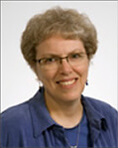
Family Physician
Agassiz Medical Centre, Morden
EMR user since 1999
“Being involved with an EMR vendor that has regular user meetings and gets input from users on the software is invaluable to having a better EMR product.”
Biggest Challenge when first started using an EMR
Biggest challenge when moving from a paper system was deciding what info to scan in or input manually into the system.
While not the biggest challenge, incorporating the EMR meant practicing where to focus her attention. Patients might continue to talk while she searched for data in the EMR. Keeping track of both things at the same time took getting used to.
Best parts of using an EMR
- Legibility: all patient charts in the clinic are legible to any care provider or staff member.
- Quick access to chart information: she can quickly see diagnostic image reports, lab results and consultation results.
- Quick access to other patient charts: it’s easy for her to pull up family members charts. This comes in handy when a mother has a child with her, for example.
Advice to those starting out
If starting out is looking for a system: get demos from other users, not just the vendors. This way, you hear the pros and cons of the system.
“If starting out is using the EMR once you have chosen it: have regular training sessions. There is so much the system can do, but at the start it is overwhelming and you forget a lot of what you are shown.”
Daily use
Setting up where you put documents is crucial to finding the information in the future. At the start of our migration to a new EMR we started putting X-rays, CT, US, MRI all in a category diagnostic images. Within a year, after advice from a different trainer we put the documents in separate categories CT, US, MRI, etc so much easier to find in the years to come. It would have been much better to do this from day one.”
Tip
“If you do obstetrics, you can pull a report to see how many due dates you have in a month.”
Dr. Shauna McQuarrie

Family Physician
EMR user since 2010
“You will benefit from having someone teach you what the implications of the decisions you make are when setting up your EMR.”
Biggest Challenge when first started using an EMR
Lab linking was the most difficult. Why? Being able to link labs is integral to capitalizing on the power of the EMR, but it can be difficult to do accurately unless you’ve named your lab tests to reflect the test and substance tested so that they can be easily identified in order to link them. At first it was difficult to understand how to name the tests, and the implications of naming conventions.
Best parts of using an EMR
- The ability to pull labs, document types, and medications into different configurations which improves the usability of information presented to the user. For example, using tags in a template to generate a referral letter.
- The fact that the user can type rather than write and fax prescriptions electronically.
- The ability to create clinically relevant reports. A good example of this is a report that lists all individuals who have been prescribed a medication that has now been recalled.
Advice to those starting out
Shauna believes there is a huge advantage in having a trainer who has experience in using the EMR in a practice somewhat similar to your own. Ensure the main individual training you and your team is a clinician that understands your practice. You’ll both speak the same language and they will be familiar with how you work. You will benefit from having someone teach you what the implications of the decisions you make are when setting up your EMR.
Daily use
Shauna uses the graphing function to show her patients lab results in the EMR. She says that patients respond well to this because it becomes easier for them to see how changes in disease management affect (lab) outcomes.
Tip
Take the time in the beginning to organize your EMR, create templates and macros, link labs, and use the experience and feedback from all of your colleagues, including support staff.
April Mills

Primary Care Nurse
Prairie Trail at the Oaks, Seven Oaks General Hospital, Winnipeg
EMR user since 2011
“Don’t get discouraged! Case-based scenarios are the best to use when doing orientation.”
Biggest Challenge when first started using an EMR
When she first started using an EMR, April said it was challenging for her to learn what clinical information needed to go in which location and what the correct terminology was.
Best parts of using an EMR
- Trending lab results (such as INRs): April said these results help her with efficiency and patient safety.
- eChart Manitoba access: “Having the ability to access eChart Manitoba directly from a chart is amazing, and patients appreciate the depth of information available to providers.”
Advice to those starting out
“Take it one step at a time: if you are willing to put a little bit of up front time and effort, and the reward at the end is worth it.”
Daily use
As a nurse and diabetes educator, most of April’s interaction with patients while using the computer is to discuss the patient’s results and review past results. She also uses eChart Manitoba for immunizations, medications and lab/imaging results to make patient care more seamless, timely, and safe.
Tip
Monthly staff meetings can be used in part to share EMR tips. “Enter as much information as possible when you start as it will save time, and be safer for the patient if they are seeing someone else on the team. There are champions in the EMR world that can help. Reach out to them.”
Jim Neufeld

Clinic Manager
C.W. Wiebe Clinic, Winkler
EMR user since 1999
“The EMR is about getting useful, needed information into the hands of the person providing the care.”
Biggest Challenge when first started using an EMR
Jim began his work as clinic manager with an EMR. The clinic learned some lessons early in EMR use, including which hardware to use. Learning was also required to set up EMR access, so that specific providers had access to the right patient information for their job.
Best parts of using an EMR
- Organization: Staff and clinicians no longer spend time looking for the right information. Everyone can get the information they need from the patient – at the same time.
- Continuity of care across care providers: the clinic is made up of a lot of physicians who provide care in other settings as well (emergency, obstetrics). If a patient shows requiring care, the EMR ensures that another provider has all the information needed to make an informed clinical decision.
- Efficiency: there aren’t as many steps to complete clinic tasks.
Advice to those starting out
“Consider what exactly you want to accomplish in your clinic, and you can assess how an EMR can help you achieve those goals.”
Daily use
The clinic runs reports regularly to better understand the patient population. This information is used to help the clinic meet patient needs by identifying areas where recruitment is required.
The clinic also runs audit reports to make sure that proper security is being maintained within the clinic’s EMR.
Tip
He recommends having some standard EMR processes while allowing flexibility in others. In his clinic, standard processes are necessary around billing, for example, to make sure the right information is always being collected. However, the clinic also allows some flexibility to suit individual health-care providers’ work styles. For example, providers are able to set up medications as favourites for easy prescribing.
Dr. Harsahil Singh

Family Physician
Family Practitioner in Oncology
Co-Lead, Primary Health and Community Services Provincial Clinical Team, Shared Health
Medical Director – Primary Care Clinics, Northern RHA
EMR user since 2013
“Patients are generally delighted and amazed to know how technology helps in improving the quality of medical care provided to them.”
Biggest Challenge when first started using an EMR
Doing prescription refills. In his region this has to be done using paper documents from the pharmacy which are scanned into the EMR and then compared to the electronic prescription. This can lead to risk of errors and is time consuming to complete.
There is so much to be gained from having pharmacies integrated electronically with the EMR to request prescription refills in terms of safety and efficiency. Integration would also mean prescriptions could be sent electronically through secure channels rather than using the slower and inefficient faxing system used today.
Best parts of using an EMR
- The ability to access other documentation, especially from a multidisciplinary team. He finds it helpful to find any notes without shifting through pages on thick volumes of paper charts. This makes it easier to find relevant information in a timely way.
- Auto-population of demographics on most EMR-related forms saves time. Paper charts have to be completed manually or by using stickers/labels which are time consuming and can lead to errors.
- Efficiencies in prescriptions such as the ability to check interactions, do refills, check expiry dates and more. He notes that using an EMR enables higher safety standards compared to using paper.
Advice to those starting out
“Ask questions about anything you don’t understand early on, rather than doing things wrong based on your assumptions. Learn about ways to improve communication between your care team members leveraging the EMR functionality to streamline patient care activities.”
Daily use
Showing patients their results from diagnostic tests, sharing notes from specialists and completing and submitting necessary requisitions for more testing right in front of the patient helps them feel reassured.
Tip
It is very important to clean up any inactive prescriptions from your active list to avoid multiple interactions and multiple duplicate prescriptions alerts.
Dr. Roy Smith
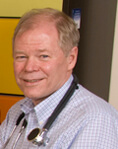
Family Physician
Meadowood Medical Centre, Winnipeg
EMR user since 2002
“With better access to data, I think I take better care of my patients.”
Biggest Challenge when first started using an EMR
Getting info from the paper chart into the computer took time. He didn’t import all of the information, only what he deemed important, for example past medical history, family history, medications, and allergies. The first year is a ‘getting used to’ period, as people are living in the hybrid world of information on paper and in the EMR. It takes time.
Best parts of using an EMR
- Access to information: he never has to look for a chart and it never gets misfiled. With information only a few clicks away: “I can review data quickly and make better decisions for patient management,” he says.
- Writing prescription repeats: he no longer has to write out the prescription and then rewrite all the same data into the chart.
- Forms: filling out forms is much quicker. The computer fills in a lot of information automatically.
Advice to those starting out
Know what goals you would like the EMR to accomplish and choose an EMR that can satisfy those goals. “It costs time and money otherwise,” he says.
They made a list of which features they needed, and toured clinics in Winnipeg, Winkler, Morden, and Steinbach that were using the potential products. By asking both the physicians and the staff about their systems, the implementation process, and their experience since implementation, his clinic was able to choose the right vendor and plan well for implementation.
Daily use
He has better control over patients with chronic diseases. For example, with one click he can look at the all of a patient’s blood pressure results to see if they are in line or out of line.
The EMR’s reporting feature has helped the clinic in many ways. It’s enabled easier analysis on patient population. For example, it can report the percentage of diabetics who had a specific test. It has also helped in other situations, for example when a medication had new dosage guidelines. A report can show which patients on the medicine exceed the new dosage guidelines.
Tip
Get together with others in the clinic to share EMR knowledge. There are a variety of ways to accomplish the same task, and you might learn a more efficient way to do something.
Tina Sorensen

Benefits and Evaluation Specialist
Nine Circles Community Health Centre, Winnipeg
EMR user since 2010
“An EMR can be used more widely than just in a medical clinic, it can be useful in an integrated community health setting as well.”
Biggest Challenge when first started using an EMR
Her biggest challenge was learning what and where to enter information for accurate reports. Tina had to learn which boxes have to be clicked, what fields have to be filled in, and what is and isn’t reportable.
Best parts of using an EMR
- The query builder: because of the quality control, increased client safety, and accurate reporting of visit statistics.
- The tasks tool: because it is a secure way to communicate with other staff about a client.
- The patient status drop-down box in the demographics: because it is customizable and an easy way to sort and identify certain client cohorts.
Advice to those starting out
“When running reports, cast a wide net. Once the report is exported, cut out the data you don’t need. Staff may have made new appointment types or new encounter note titles that you wouldn’t have been able to identify in the reports if you had constrained the search terms too narrowly.”
Daily use
Tina uses the EMR to gather statistical information, like appointments, visits, program monitoring, and reports. It’s very useful when looking for all of a doctor’s patients who have a specific diagnosis, who are also taking a certain medication.
Tip
Make a “dummy” chart and a “dummy” provider and practice entering information into the reporting functions, such as the query builder and the EMR’s canned reports. This way you can learn how and where to enter the information to run accurate reports. It will also give you a chance to test out any workarounds and see if they will still produce accurate reports.
Debbie Steiss

Office Administrator
Portage Clinic, Portage la Prairie
EMR user since 2004
“We strive to be a paperless clinic, therefore, any forms we can fax from within our EMR without having to print them off and fax manually, is an office efficiency that we utilize daily.”
Biggest Challenge when first started using an EMR
“Entering all our forms into the system and setting up all our users with the correct security permissions.”
Best parts of using an EMR
- Query Building – just the sheer amount of knowledge you can gain from running queries is very useful. It also holds you accountable for the information that you put into your EMR. Any searchable data must be put into a component you can actually search for.
- Form Editing – supports our goal of being a paperless clinic.
- Interfaces between our EMR and other systems – for example, connecting digital medical devices, generating and sending automated appointment reminders, data sharing and telemedicine – all improve the workflow within the clinic and keep us moving forward with efficiencies.
Advice to those starting out
“I use the EMR daily for scheduling, running reports for our My Health Team as well as reporting to support PHIA audits, chronic disease billing and EMR data quality in general. I also use it as a communication tool to email with staff, correspond with physicians, set up online booking appointments, and review and act on tasks.”
Daily use
“I would advise new users to start slow. A lot of times you want to “jump right in” and get moving with change, but it’s better to introduce one piece of the puzzle at a time until you can start to finally see the benefits and workflow a little clearer.”
Tip
“After initial training, take time to work your way through all sections of the EMR until you understand each piece. Read and review the User Guides and break learning into sections relevant to clinic roles or different departments. Share these sections of the manuals with the relevant staff. Learning the system as a whole gave me a great understanding of the capabilities, short cuts, and ways to improve work flow. It’s not a race, it’s a commitment to having great charting. I always like the motto “garbage in, garbage out”. It really does make a difference what and where you put information into your EMR.”
Dr. Shawn Thomas
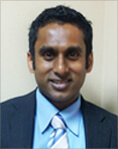
Family Physician
Concordia Health Associates, Winnipeg
EMR user since 2006
“For me, family time’s at a premium, and the EMR’s efficiency helps me maximize that time.”
Biggest Challenge when first started using an EMR
Creating a plan a few months in advance made the change as smooth as possible. A clinic manager worked with the each physician to understand what elements of the paper chart were most important to them. Then, working with clinic staff as well, current processes were reviewed and redesigned to incorporate the EMR. “We knew it would take months, so we started early.”
When the EMR was turned on in the clinic, users had access to cheat sheets for quick reminders and physicians also had ready access to the paper chart until they were comfortable that the EMR housed the necessary information.
Best parts of using an EMR
- Access: he can access information quickly, and he is able to see his week at a glance.
- Prescription refills: with a few clicks, he is able to refill prescriptions. This is especially helpful when there are multiple prescriptions to fill.
- Legibility and standard communication: If another physician has seen his patient, he can see what was prescribed and what they’ve done with the patient.
Advice to those starting out
For those moving from paper to EMR: he recommends reducing the number of appointments to 60-70 per cent in the beginning, and gradually scheduling more appointments as providers become more familiar with the EMR. “Otherwise, you’ll get real frustrated real quick.”
He also recommends investing in a project manager or assigning that role to someone in the clinic. “You need a go-to person.”
Daily use
He says there is better time management in the clinic overall through the use of the EMR’s task function. The referral clerk and clinic manager use tasks to track whether a response has come in or not. If not, they can re-send the request or otherwise act on it.
Tip
Monthly staff meetings can be used in part to share EMR tips.
